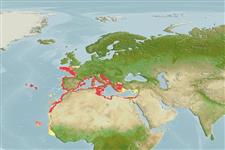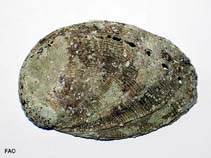Haliotis tuberculata Linnaeus, 1758
Tuberculate abalone| Native range | All suitable habitat | Point map | Year 2050 |

|
| This map was computer-generated and has not yet been reviewed. |
| Haliotis tuberculata AquaMaps Data sources: GBIF OBIS |
Classification / Names Common names | Synonyms | CoL | ITIS | WoRMS
Gastropoda | Lepetellida | Haliotidae
Environment: milieu / climate zone / depth range / distribution range Ecology
Benthic; depth range 0 - 200 m (Ref. 2754). Subtropical, preferred 19°C (Ref. 107945); 50°N - 9°N, 32°W - 36°E (Ref. 99669)
Distribution Countries | FAO areas | Ecosystems | Occurrences | Introductions
Eastern Atlantic and the Mediterranean: North to the Channel Islands, south to Guinea, including Azores, Canary and Cape Verde Islands, and east to the Mediterranean. Introduced in Ireland and Gulf of Aqaba, Red Sea in Israel.
Length at first maturity / Size / Weight / Age
Maturity: Lm 4.9, range 4 - 5.4 cm Max length : 12.3 cm SHL male/unsexed; (Ref. 99669); common length : 8.0 cm SHL male/unsexed; (Ref. 438); max. reported age: 15 years (Ref. 99669)
Life cycle and mating behavior Maturity | Reproduction | Spawning | Eggs | Fecundity | Larvae
Main reference
References | Coordinator | Collaborators
Demir, M. 2003 Shells of mollusca collected from the seas of Turkey. Turkey Journal of Zoology 27:101-140. (Ref. 2754)
IUCN Red List Status
(Ref. 130435: Version 2025-1)
CITES status (Ref. 108899)
CMS (Ref. 116361)
Threat to humans
Human uses
Fisheries: commercial
FAO - Aquaculture: production; Fisheries: landings | FishSource | Sea Around Us
Tools
More information
Max. ages / sizes
Length-weight rel.
Length-length rel.
Length-frequencies
Mass conversion
Abundance
Internet sources
BHL | BOLD Systems | CISTI | DiscoverLife | FAO(Fisheries: ; publication : search) | Fishipedia | GenBank (genome, nucleotide) | GloBI | Gomexsi | Google Books | Google Scholar | Google | PubMed | Tree of Life | Wikipedia (Go, Search) | Zoological Record



